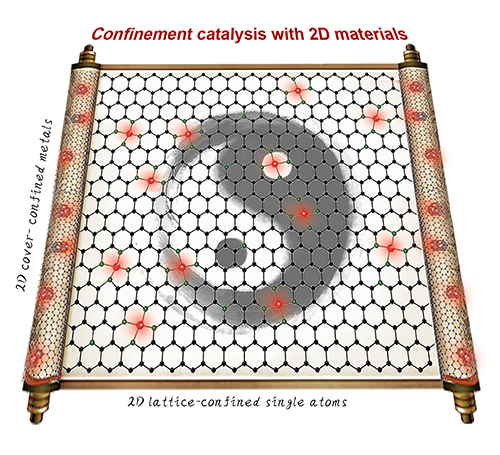A research team led by Prof. DEND Dehui and Prof. BAO Xinhe reviewed the progress of confinement catalysis with 2D materials for energy conversion. The article was published in Advanced Materials.

Confinement Catalysis with 2D Materials for Energy Conversion. (Image by TANG Lei and GAO Hehua)
The unique electronic and structural properties of 2D materials have triggered wide research interest in catalysis. The lattice of 2D materials and the interface between 2D covers and other substrates provide intriguing confinement environments for active sites, which has stimulated a rising area of “confinement catalysis with 2D materials.”
Fundamental understanding of confinement catalysis with 2D materials can favor the rational design of high-performance 2D nanocatalysts. Confinement catalysis with 2D materials has found extensive applications in energy-related reaction processes, especially in the conversion of small energy-related molecules such as H2, O2, CH4, CO, CO2, H2O, and CH3OH.
Two representative strategies, i.e., 2D lattice-confined single atoms and 2D cover-confined metals, have been applied to construct 2D confinement catalytic systems with superior catalytic activity and stability.
Scientists summarized recent advances in the design, applications, and structure–performance analysis of two 2D confinement catalytic systems. The different routes for tuning the electronic states of 2D confinement catalysts were highlighted and perspectives on confinement catalysis with 2D materials toward energy conversion and utilization in the future were provided.
The above work was supported by Ministry of Science and Technology of China, Major Project of National Natural Science Foundation of China, Key Research Program of Frontier Sciences of CAS, and Collaborative Innovation Center of Chemistry for Energy Materials (2011. iChEM), etc. It was dedicated to the 70th anniversary of DICP. (Text by TANG Lei and GAO Hehua)